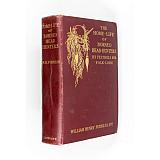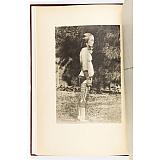"the most artistically tattooed man in the world"
The Home-Life of Borneo Head-Hunters.
Its Festivals and Folk-Lore. Philadelphia J.B. Lippincott 1902
First edition, pp.xi, 197, complete with 88 fine Heliotype plates each with a descriptive tissue guard. One of only 500 copies issued. A very good copy in the original gilt-decorated cloth, top edge gilt. Stitching weak as usual due to the excessive weight of plates bound in. Very slight rubbing to extremities, light bumping to corners and spine, single crease to spine. Internally clean and unblemished. Discreet bookplate of "Robert & Maria Travis" to front paste-down, and traces of an earlier bookplate.
William Henry Furness III (1866-1920), an American physician, was one of the first Westerners to encounter the Kayan people of Borneo and the Wa'ab people of Yap. This work is the product of four expeditions Furness made between 1895 and 1901 accompanied by two like-minded physicians: Hiram M. Hiller, Jr. and Alfred C. Harrison, Jr. While their expeditions were primarily ethnographic, they also collected a considerable amount of biological and archaeological artefacts that became one of the founding collections of the University of Pennsylvania Museum of Archaeology and Anthropology. Furness spent most of his time in Borneo among the Kayans and Kenyahs of the Baram District of Sarawak. He devotes chapters to their home life, ceremonies, early head-hunter training, war expeditions, peace-making, personal embellishment, taboo and tuba fishing, all with copious amounts of accompanying photographs that excellently illustrate the ways of life of the people he met. He shows particular interest in tattooing and was himself liberally tattooed during an earlier visit to Japan at a time when it was still frowned upon in the West for respected gentlemen to decorate their skin: he was described in 1894 as "the most artistically tattooed man in the world". The Heliotype plates are a fine example of the earliest commercial photography, the Kodak Brownie being released only a year prior, and are extremely successful in conveying not just the landscapes and villages Furness visited but the people that he met. There are at least 30 single or group portraits of the indigenous people Furness encountered, with many more being included in domestic scenes.




